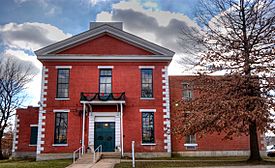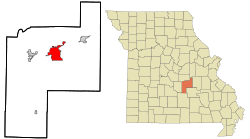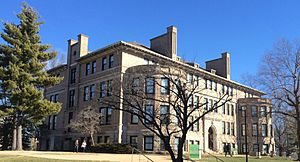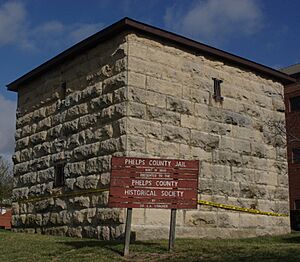Rolla, Missouri facts for kids
Quick facts for kids
Rolla, Missouri
|
||
|---|---|---|
| City of Rolla | ||

Old Phelps County Courthouse
|
||
|
||
| Motto(s):
"The Middle of Everywhere."
|
||

Location of Rolla within County and State
|
||
| Country | United States | |
| State | Missouri | |
| County | Phelps | |
| Founded | 1858 | |
| Area | ||
| • Total | 12.15 sq mi (31.47 km2) | |
| • Land | 12.13 sq mi (31.41 km2) | |
| • Water | 0.02 sq mi (0.05 km2) | |
| Elevation | 1,099 ft (335 m) | |
| Population
(2020)
|
||
| • Total | 19,943 | |
| • Estimate
(2025)
|
20,754 | |
| • Density | 1,644.24/sq mi (634.86/km2) | |
| Time zone | UTC-6 (Central (CST)) | |
| • Summer (DST) | UTC-5 (CDT) | |
| ZIP codes |
65401, 65402, 65409
|
|
| Area code(s) | 573 | |
| FIPS code | 29-62912 | |
| GNIS feature ID | 2396418 | |
| Website | rollacity.org | |
Rolla is a city located in Phelps County, Missouri, United States. It is the main city and the county seat of Phelps County. In 2020, about 19,943 people lived there. Rolla is located almost exactly halfway between the larger cities of St. Louis and Springfield along I-44.
The city is home to the Missouri University of Science and Technology, often called Missouri S&T. This university is famous for its engineering and computer science programs. Rolla is also where the main office for the Mark Twain National Forest is located. The area is known for its vineyards, which were first started by Italian immigrants.
Contents
History of Rolla
The first European-American settlers came to Phelps County in the early 1800s. They were farmers and iron workers near rivers like the Meramec and Gasconade. In 1842, John Webber built the first house in what would become Rolla. Later, in 1851, Edmund Ward Bishop, who is seen as the founder of Rolla, settled in the area. Rolla officially became a town in 1858.
How Rolla Got Its Name
There are a few stories about how Rolla got its name.
- One popular story, which is likely a legend, says that Rolla and a nearby town called Dillon were competing to be the county seat. When Rolla won, the people of Dillon supposedly named the new city "Rolla" after a lazy hunting dog.
- Another story says that during a meeting to name the town, John Webber wanted to call it "Hardscrabble." Edmund Bishop preferred "Phelps Center." George Coppedge, who came from North Carolina, wanted to name it after Raleigh. Bishop agreed to "Raleigh" if it was spelled "Rolla" to fit the local area.
- The most believable story comes from Adeline Rose, who said in 1903 that the town was named after her husband, Rolla Rose. He had carved his name on a tree during a hunting trip in the 1840s so he wouldn't get lost.
Rolla During the Civil War
During the American Civil War, many people in Rolla supported the Confederacy. However, Union soldiers took control of the town in June 1861. They built two small forts, Fort Wyman and Fort Dette, to protect the area. Rolla was also a base for Union troops.
Rolla as a Transportation Hub
For a long time, Rolla has been an important center for travel and trade. In 1860, it became the end point of the first part of the St. Louis–San Francisco Railway. This railway was known as the "Frisco Line." Today, the BNSF Railway still runs through the city.
Rolla was also a regular stop on the famous U.S. Route 66. This was because it was almost exactly halfway between St. Louis and Springfield. Today, major highways like Interstate 44, U.S. Route 63, and Route 72 all pass through Rolla.
Geography and Climate
Rolla covers about 11.85 square miles. Most of this area is land, with a small amount of water. The city is located on a natural dividing line. This line separates the large Missouri watershed from the smaller Meramec watershed. This means that rain falling on one side of the line flows into the Missouri River, and rain on the other side flows into the Meramec River.
Climate in Rolla
Rolla has a humid subtropical climate. This means it has hot, humid summers and mild winters.
| Climate data for Rolla, Missouri (Missouri University of Science and Technology), 1991–2020 normals, extremes 1896–present | |||||||||||||
|---|---|---|---|---|---|---|---|---|---|---|---|---|---|
| Month | Jan | Feb | Mar | Apr | May | Jun | Jul | Aug | Sep | Oct | Nov | Dec | Year |
| Record high °F (°C) | 78 (26) |
84 (29) |
91 (33) |
93 (34) |
99 (37) |
105 (41) |
113 (45) |
108 (42) |
105 (41) |
94 (34) |
85 (29) |
79 (26) |
113 (45) |
| Mean maximum °F (°C) | 66.1 (18.9) |
70.7 (21.5) |
78.5 (25.8) |
85.0 (29.4) |
88.9 (31.6) |
93.1 (33.9) |
97.9 (36.6) |
98.0 (36.7) |
92.6 (33.7) |
85.4 (29.7) |
75.6 (24.2) |
66.9 (19.4) |
99.7 (37.6) |
| Mean daily maximum °F (°C) | 40.9 (4.9) |
46.1 (7.8) |
56.0 (13.3) |
67.2 (19.6) |
75.9 (24.4) |
84.1 (28.9) |
88.9 (31.6) |
88.1 (31.2) |
80.4 (26.9) |
69.1 (20.6) |
55.7 (13.2) |
44.8 (7.1) |
66.4 (19.1) |
| Daily mean °F (°C) | 31.7 (−0.2) |
36.1 (2.3) |
45.4 (7.4) |
56.3 (13.5) |
65.8 (18.8) |
74.3 (23.5) |
78.8 (26.0) |
77.6 (25.3) |
69.6 (20.9) |
58.2 (14.6) |
46.0 (7.8) |
36.0 (2.2) |
56.3 (13.5) |
| Mean daily minimum °F (°C) | 22.4 (−5.3) |
26.2 (−3.2) |
34.8 (1.6) |
45.4 (7.4) |
55.7 (13.2) |
64.6 (18.1) |
68.7 (20.4) |
67.1 (19.5) |
58.9 (14.9) |
47.3 (8.5) |
36.4 (2.4) |
27.2 (−2.7) |
46.2 (7.9) |
| Mean minimum °F (°C) | 2.9 (−16.2) |
7.6 (−13.6) |
17.0 (−8.3) |
30.8 (−0.7) |
40.6 (4.8) |
53.6 (12.0) |
59.8 (15.4) |
58.4 (14.7) |
44.6 (7.0) |
31.9 (−0.1) |
19.9 (−6.7) |
8.8 (−12.9) |
−0.7 (−18.2) |
| Record low °F (°C) | −24 (−31) |
−22 (−30) |
−3 (−19) |
13 (−11) |
31 (−1) |
40 (4) |
49 (9) |
42 (6) |
32 (0) |
19 (−7) |
3 (−16) |
−19 (−28) |
−24 (−31) |
| Average precipitation inches (mm) | 2.73 (69) |
2.49 (63) |
4.14 (105) |
4.90 (124) |
5.48 (139) |
4.37 (111) |
4.74 (120) |
4.52 (115) |
4.00 (102) |
3.26 (83) |
3.92 (100) |
2.83 (72) |
47.38 (1,203) |
| Average snowfall inches (cm) | 5.6 (14) |
4.1 (10) |
2.6 (6.6) |
0.2 (0.51) |
0.0 (0.0) |
0.0 (0.0) |
0.0 (0.0) |
0.0 (0.0) |
0.0 (0.0) |
0.1 (0.25) |
1.3 (3.3) |
3.4 (8.6) |
17.3 (44) |
| Average precipitation days (≥ 0.01 in) | 9.4 | 9.1 | 12.1 | 11.8 | 13.0 | 10.3 | 9.4 | 9.1 | 8.3 | 8.8 | 9.5 | 9.2 | 120.0 |
| Average snowy days (≥ 0.1 in) | 4.9 | 4.7 | 2.7 | 0.5 | 0.0 | 0.0 | 0.0 | 0.0 | 0.0 | 0.1 | 1.1 | 3.8 | 17.8 |
| Source: NOAA | |||||||||||||
Population of Rolla
| Historical population | |||
|---|---|---|---|
| Census | Pop. | %± | |
| 1870 | 1,354 | — | |
| 1880 | 1,582 | 16.8% | |
| 1890 | 1,592 | 0.6% | |
| 1900 | 1,600 | 0.5% | |
| 1910 | 2,261 | 41.3% | |
| 1920 | 2,077 | −8.1% | |
| 1930 | 3,670 | 76.7% | |
| 1940 | 5,141 | 40.1% | |
| 1950 | 9,354 | 81.9% | |
| 1960 | 11,132 | 19.0% | |
| 1970 | 13,571 | 21.9% | |
| 1980 | 13,303 | −2.0% | |
| 1990 | 14,090 | 5.9% | |
| 2000 | 16,367 | 16.2% | |
| 2010 | 19,559 | 19.5% | |
| 2020 | 19,943 | 2.0% | |
| 2023 (est.) | 20,423 | 4.4% | |
| U.S. Decennial Census | |||
The population of Rolla has grown steadily over the years. In 2020, the city had 19,943 people. There were 8,470 households and 4,141 families.
Diversity in Rolla
Rolla is a diverse city. In 2020, most residents (about 80.55%) were White. Other groups included Black or African-American (4.21%), Asian (6.26%), and Native American (0.51%). About 6.97% of people were from two or more races. People of Hispanic or Latino background made up about 3.3% of the population.
Age Groups in Rolla
The city has a younger population compared to many places. In 2020:
- 17.5% of people were under 18 years old.
- 29.7% were between 18 and 24 years old.
- 23.8% were between 25 and 44 years old.
- 16.4% were between 45 and 64 years old.
- 14.2% were 65 years or older.
The average age in Rolla was about 26.8 years.
Economy and Jobs
Rolla is home to several important businesses.
- Royal Canin has a large factory in Rolla that makes food for dogs and cats.
- Brewer Science is a company based in Rolla that makes special materials for creating computer chips.
- Hartmann North America started making molded-fiber egg packaging in Rolla in 2017. They also make fruit packaging and machines for food packaging. They use a former Briggs & Stratton plant for their operations.
Education and Research
Rolla has a strong focus on education and science.
- Rolla High School and Rolla Middle School are part of the local school system. Their sports teams are called the Rolla Bulldogs.
- Missouri University of Science and Technology (Missouri S&T) is a major university in Rolla. It was founded in 1870 and is known for its excellent engineering and computer science programs.
- The US Geological Survey has a large office in Rolla. This facility includes centers for geospatial operations, water science, and geographic science. They also have a library.
- The Rolla Public Library is available for everyone in the community to borrow books and other materials.
Local Media
Rolla has its own local newspaper, the Phelps County Focus, which comes out every week. There are also several local radio stations, including KUMR, KRTE-FM, KFLW, KFBD, KTTR, KMOZ, KTTR-FM, KZNN, KXMO, and KKID. KMST is the public radio station, and KMNR FM is the student radio station at Missouri S&T.
Places to Visit
Rolla has several interesting places, some of which are listed on the National Register of Historic Places.
- Historic Buildings: You can see the National Bank of Rolla Building, the Phelps County Courthouse, and the Phelps County Jail. The Rolla Ranger Station Historic District and the former US Bureau of Mines headquarters are also historic sites.
- Missouri S&T Campus: The university campus has a half-scale replica of Stonehenge made from solid granite. It also has an astronomical observatory and a working nuclear reactor, which was the first in Missouri.
- Museums and Centers: Visit the Missouri Department of Natural Resources, Division of Geology and Land Survey, and the Ed Clark Museum of Missouri Geology. The United States Geological Survey also has a facility here.
Famous People from Rolla
Many notable people have connections to Rolla, including:
- Jim Boo (born 1954), a former professional ice hockey player.
- Jean Carnahan (1933–2024), a former US Senator.
- Mel Carnahan (1934–2000), a former Governor of Missouri.
- Shannon Miller (born 1977), an Olympic gold medalist in gymnastics.
- Mayme Ousley (1887–1970), the first woman elected mayor of a town in Missouri.
- Timothy M. Dolan (born 1950), a Cardinal and Archbishop of New York.
Sister City
Rolla has a sister city relationship with Sondershausen, a town in Thuringia, Germany.
See also
 In Spanish: Rolla (Misuri) para niños
In Spanish: Rolla (Misuri) para niños





